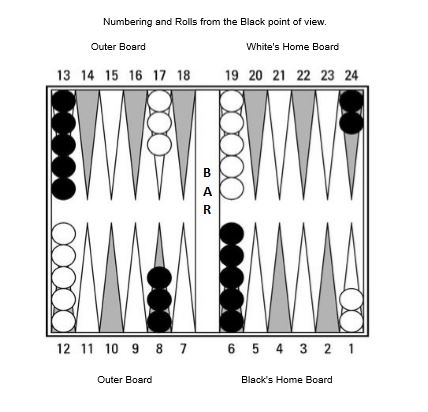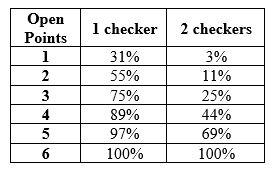Last updated on October 30, 2025
In this Deluxe Backgammon post for beginners, we discuss what a strong home board is and how it influences decision making during play. If you are an absolute beginner, it is worth reading the post about backgammon setup before proceeding with this article. The home or inner board is the quadrant into which you must move all of your checkers before you can start bearing off. If contact has been broken, that is, checkers can no longer be hit, the game is down to a race (Backgammon races at Backgammon Galore). In this instance, the home board strength is mainly dependent on distribution, as this influences the amount of wastage when bearing off. In this post, we will focus on playing considerations when contact has not been broken.
Home board
In simple terms, backgammon home board strength refers to the number of secure points within the quadrant. A secure point is one stacked with two or more of your checkers. There are three benefits of a secure point within the home board. First, it provides a blocking point for your opponent’s checkers. Second, it provides a safe landing place for your own checkers. Third, it provides a barrier to re-entry from the bar. At the start of the game, the 6-point is secure, which provides a single blocking point for the back checkers. If one of your opponent’s checkers is hit early in the game, the 6-point blocks re-entry with any die roll of 6. As the game progresses, you will hope to secure more points within the home board, with the priority being the 5-point.
The ideal scenario is to build a series of adjacent secure points to form a prime. The longer the prime, the harder it is for the back checkers to escape, and the harder it is to re-enter. The ultimate situation is to create a 6-prime and close out the home board.
Re-entry from the bar
A six-prime within the home board makes it impossible to re-enter from the bar, as every entry point is blocked. The table below shows the relative difficulty of re-entering according to the number of open points. As we have already noted, it is impossible to re-enter when the home board is closed with a six-prime. If there are five open points, typically points 1-5, the possibility of re-entry is 97%, with failure only on a roll of 6-6. The more points that are secured, the harder it is to re-enter. Even once a checker has re-entered, the secure points still have a blocking value for subsequent moves (How to Calculate Backgammon Probabilities at ThoughtCo.).
The effect on gameplay
It is the relative strengths of the opposing home boards that determine the style of play for each player. Imagine if your opponent’s home board has two secure versus your own with four secure points. Your opponent has to adopt a more risk averse style of play because if they get hit, they have a 45% chance of staying on the bar, potentially losing a turn and falling behind in the race. You, on the other hand, only have an 11% of failing to re-enter if hit. This allows you to play much more freely and take more risks. If the play moves towards a hitting contest, the player with the stronger home board has a significant advantage.
The situation changes a little if we start considering blots within the home boards amongst the secure points. For example, given the scenario in the previous paragraph, with the addition of a blot amongst the four secure checkers in your home board. That blot could represent an opportunity for your opponent. This is because if they are hit, there is a chance of hitting back on return (Leaving blots at The Gammon Press). This means that they can ease off on the defensive play while the blot is in place.
Related content
Backgammon at Wikipedia.



The relative strengths of the home boards, is the key point. Whoever has the strongest chance of reentering can play the most aggressively. Goods tips.